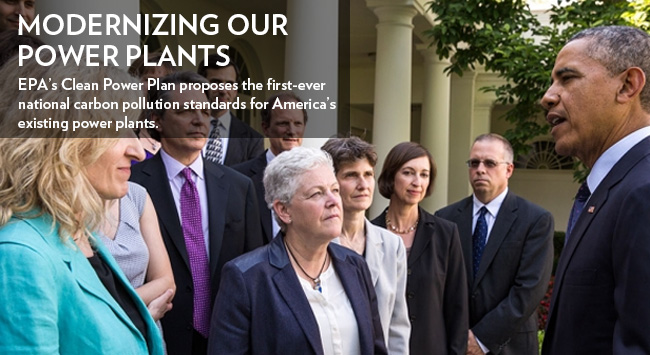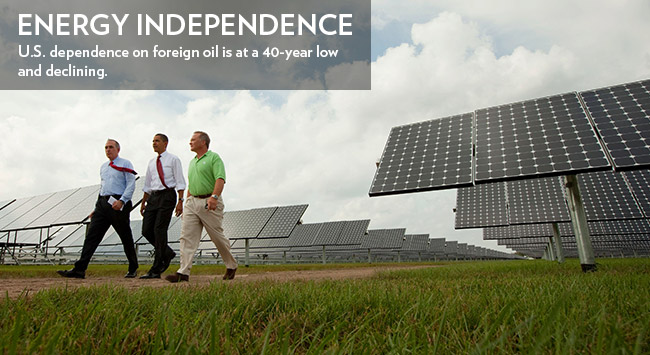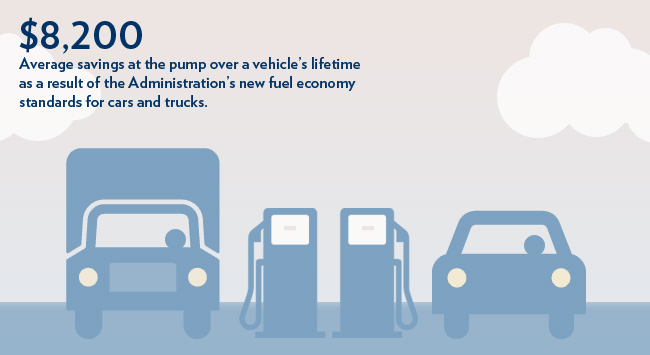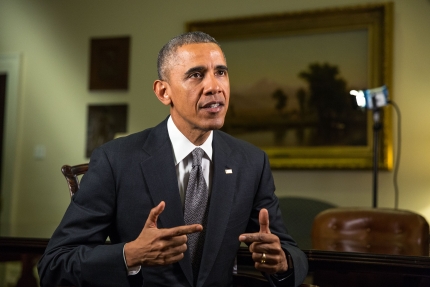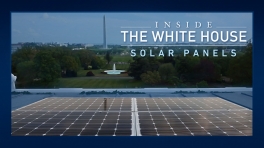Energy and Environment Latest News
Weekly Address: Climate Change Can No Longer Be Ignored
Posted by on April 18, 2015 at 6:00 AM EDTIn this week’s address, the President spoke about his commitment to combatting the threat of climate change and to keeping ourselves and future generations safe. The effects of climate change can no longer be denied or ignored – 2014 was the planet’s warmest year recorded, and 14 of the 15 hottest years on record have happened this century.
Climate change poses risks to our national security, our economy, and our public health. The President has already taken historic steps to address climate change, but there’s more that the United States and the international community can do. That’s why next Wednesday, on Earth Day, in the latest part of his effort to call attention to and act on the threat of climate change, the President will visit the Florida Everglades and speak about the threat that climate change poses to our economy and to the world.
Transcript | mp4 | mp3
Learn more about Energy and EnvironmentEPA Launches New Website to Track Safe Drinking Water Compliance
Posted by on April 15, 2015 at 12:46 PM EDTLast week, the Environmental Protection Agency (EPA) released the Safe Drinking Water Act dashboard, a website that tracks whether public water systems are complying with the laws that keep our water safe and clean.
Clean water is a precious resource. That’s why the EPA sets standards for drinking water quality under the Safe Drinking Water Act (SDWA) and works with state, tribal, and territorial agencies to oversee implementation of those standards. At the same time, the Obama Administration continues to advance its open data initiatives – focused on unleashing data across range of topics to empower citizens, communities, entrepreneurs and businesses with the information they need to innovate and make informed decisions.
The SDWA Dashboard released last week sits at the nexus of these two important policy efforts. The Dashboard openly tracks data about water-facility inspection visits, enforcement actions, and more. Interactive charts show detailed data about facility reports for individual public water systems. Everything on the dashboard can be exported, downloaded and printed.
The SDWA Dashboard is connected to EPA’s Enforcement and Compliance History Online (ECHO) website, which hosts thousands of visitors each month who are seeking information about the compliance status of facilities in their communities. Users can also investigate pollution sources, examine and create enforcement-related maps, or explore any state's performance with respect to several environmental laws. ECHO is a great example of government transparency, and of EPA’s commitment to engage the public in environmental protection.
With expanded access to data, anyone can get informed and help play a role in keeping communities safe and healthy.
Corinna Zarek is the Senior Advisor for Open Government to the U.S. Chief Technology Officer
Lisa Lund is the Director of the Office of Compliance at the Environmental Protection Agency
Learn more about Energy and Environment,In Photos: The President’s Trip to Jamaica and Panama
Posted by on April 13, 2015 at 6:32 PM EDTPresident Obama headed to Kingston, Jamaica for a town hall with the Young Leaders of the Americas. He went on to Panama City for the seventh Summit of the Americas. Check out the visit in photos:
Learn more about Energy and Environment, Foreign PolicyKeeping Up with the Cabinet: Engaging the Next Generation to Play, Learn, Serve, and Work in the Great Outdoors
Posted by on April 10, 2015 at 1:11 PM EDT
The creative energy of youth, the serenity of nature, and the lessons of history are a winning combination for me. All three were present in this video from the Martin Luther King, Jr. National Historic Site in Atlanta, where I enjoyed an opportunity to roll up my sleeves alongside volunteers, young and old, to help plant rose bushes named for Coretta Scott King in the peace garden.
This visit helped launch our 50 Cities Initiative — an ambitious effort by the Department of the Interior's bureaus to work alongside cities, public land managers, and non-profit organizations like the YMCA, the National League of Cities, and local youth conservation corps, to engage young people in nature from city parks to national parks and all points in between.
Learn more about Energy and EnvironmentSentinel Landscapes: Win-Win-Win for Military Readiness, Conservation, and Agriculture
Posted by on April 8, 2015 at 6:28 PM EDTMilitary installations across the country support weapons testing and troop training that help keep America safe. Yet the capacity of military bases to provide these critical defense capabilities also depends on compatible uses of the private and other government lands that surround installations and ranges. Working agricultural lands are often more compatible neighbors to noisy or otherwise disruptive military activities than dense housing and development. Those same areas that can buffer military bases also provide food and forest products as well as wildlife habitat and clean water, all of which are also important to our national security.
Today, we are happy to recognize our second round of “Sentinel Landscape” partnerships being designated in Arizona, Maryland, and Delaware—Fort Huachuca and Naval Air Station Patuxent River. Implemented jointly by the Department of Defense (DoD), Department of Agriculture (USDA), and Department of the Interior (DOI), these partnerships support efforts to maintain working agricultural lands, build strong local economies, protect at-risk wildlife and water supplies, and ensure the readiness of our military. Between federal, state, private, and non-profit local commitments, partners have committed over $25 million to these landscapes from 2014 through 2017.
Around Arizona’s Fort Huachuca, DoD, the U.S. Forest Service, and U.S. Fish and Wildlife Service are working with the state government and the Arizona Land and Water Trust to reduce unsustainable subdivision and development near the Fort’s training areas and airspace. This partnership will help to keep 5,000 acres of ranchland in production, restore grasslands and wetlands, and implement the State of Arizona’s Forest Action Plan. All of these actions support Fort Huachuca’s mission as the leading training area for unmanned aircraft system training in the Western United States. Work in this Sentinel Landscape will be especially important in protecting local groundwater supplies and maintaining rare stream and wetland habitat.
The new Sentinel Landscape in Maryland and Delaware is centered on the Navy’s Patuxent River-Atlantic Test Ranges, known as ‘Pax River.’ DoD and other agencies have already protected nearly 3,000 acres of surrounding fields, farm, and forests to buffer aircraft flight zones. Future actions will help benefit wildlife and water quality in the Chesapeake Bay, including work along the Nanticoke River corridor. Pax River is the Navy’s premier aircraft research, development, and testing area. Lands and waters within the Sentinel Landscape boundary support prime fishing and other recreation for local residents and help sustain populations of more than 260 rare plant and animal species.
The Administration launched the pilot Sentinel Landscape partnership in 2013 at Joint Base Lewis McChord in Washington State’s Puget Sound region. Since then, Federal agencies have been working with state and local government and private landowners to preserve and restore habitat around the joint Army-Air Force base to protect at-risk wildlife and ensure that military training can proceed unimpeded. The joint base supports 43,000 soldiers and airmen for maneuver training and land-warrior system testing, and encompasses more than 90 percent of remaining prairie grasslands in the region. The partnership is currently pursuing a 745 acre prairie acquisition project with funds from DoD, Washington State, and U.S. Fish and Wildlife Service, moving them closer to the goal of conserving an additional 5,600 acres by 2020. USDA’s Natural Resources Conservation Service is also pursuing additional working lands easements, and local partners are making progress with stewardship demonstration projects and the reintroduction of federally-protected native species such as the Taylor’s checkerspot butterfly.
The Administration is proud of these partnerships that bring together so many partners around a shared opportunity that benefits the Nation’s defense, natural resources and food production.
For more information, you can visit www.sentinellandscapes.org.
Jay Jensen is Associate Director for Land and Water Ecosystems at the White House Council on Environmental Quality.
Learn more about Energy and EnvironmentAmerica's Doctor is Taking Your Questions: #AskTheSurgeonGeneral
Posted by on April 8, 2015 at 5:44 PM EDTYesterday, as part of Public Health Week, Surgeon General Vivek Murthy joined President Obama and EPA Administrator Gina McCarthy for a roundtable discussion with faculty at Howard University Medical School about what the Administration is doing to address climate change. He talked about the impact of climate change on public health and how prevention is the key to public health.
As Surgeon General, Dr. Murthy underscored we all have a stake in our national and global health. Every single one of us stands to benefit from a public health system that is focused on wellness and prevention — not one that simply focuses on treating sickness and disease.
Now, he wants you to join the conversation and ask him a question about the impact of climate change on health – or any other public health topic.

Starting this evening through 2:30 p.m. ET tomorrow, April 9, he'll be taking your questions on Twitter using the hashtag #AskTheSurgeonGeneral, and responding via video on @Surgeon_General throughout the afternoon on April 9.
Learn more about Energy and Environment
- &lsaquo previous
- …
- 8
- 9
- 10
- 11
- 12
- 13
- 14
- 15
- 16
- …
- next &rsaquo
White House Blogs
- The White House Blog
- Middle Class Task Force
- Council of Economic Advisers
- Council on Environmental Quality
- Council on Women and Girls
- Office of Intergovernmental Affairs
- Office of Management and Budget
- Office of Public Engagement
- Office of Science & Tech Policy
- Office of Urban Affairs
- Open Government
- Faith and Neighborhood Partnerships
- Social Innovation and Civic Participation
- US Trade Representative
- Office National Drug Control Policy

